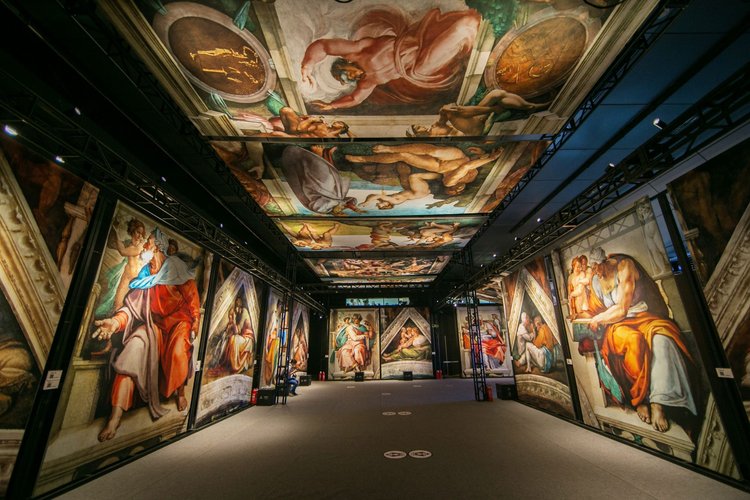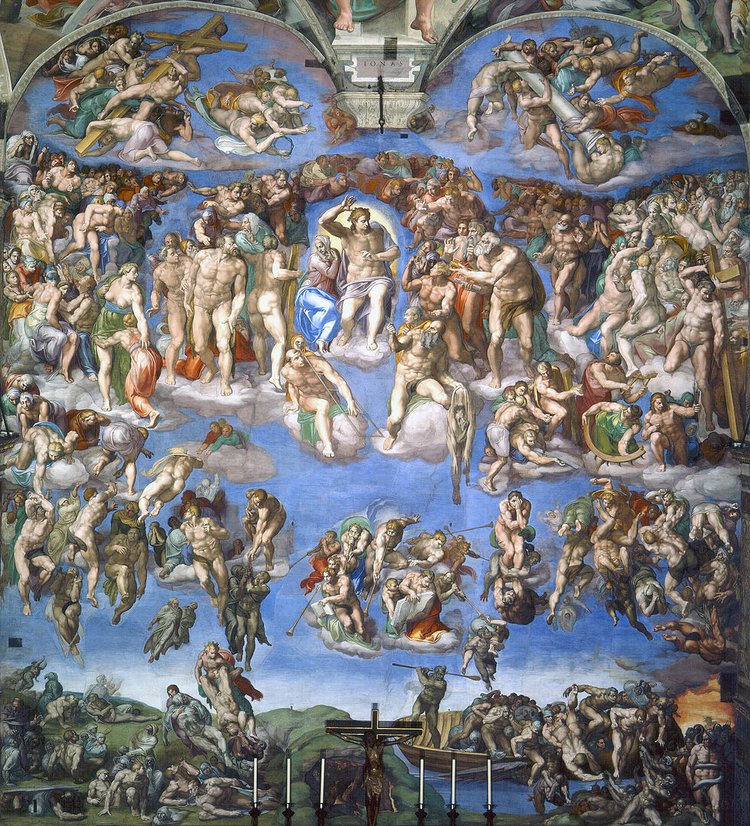(REVIEW) Want to gaze at the enormity of the Sistine Chapel without ever going to the Vatican? Now you can.
“Michelangelo’s Sistine Chapel: The Exhibition,” currently on a 27-city world tour, highlights the wonder of one of history’s greatest artistic achievements, allowing visitors to experience it like they never have before.
This exhibit is truly a chance to see Michelangelo’s work at eye level. It’s also a much cheaper and closer option than flying to Rome. For that alone, it’s worth a look.
READ: Getty Museum's Christian Manuscripts Exhibit Sees Antisemitism Where There Is None
The display of iconic works by the famed Italian Renaissance artist features music along with life-size images of 34 frescoes — 33 of which Michelangelo painted on the chapel’s interior over a period of nearly five years.
“The Last Judgment” — a depiction of the second coming of Christ and the final judgment by God of all humanity, featuring 400 people — is the final piece and covers an entire wall.
This is one way to see the frescoes on a budget and in an up-close way. And unlike when you see these at the Vatican, this exhibit allows for as much photography as you want.

“Michelangelo’s Sistine Chapel: The Exhibition,” shown here when it visited Charlotte, allows visitors to get close up with the works of the Sistine Chapel. Photo via chapelsistine.com.
The images of the frescoes — all of which are post-Restoration and took place in the early 1980s — used for the exhibit are from photographs licensed through Bridgeman Images.
The exhibit is self-guided and features placards near each work. The audio guide, which lasts nearly two hours, informs the listener about who is in each painting, why Michelangelo painted them and their importance in the Bible and church history.
Michelangelo even painted himself into a couple of the frescoes, giving the exhibit an Easter egg hunt quality if you choose to try and find him.
I’m not alone in praising this traveling exhibit. Overall, it has received rave reviews.
“The photographs are life-sized and thus easier to study than the original frescoes in Vatican City,” Michelle Smith observed in America, the Jesuit magazine that focuses on faith, culture and politics. “They are all visible without craning your neck and bumping into the tourist or pilgrim behind you.”
I couldn’t agree more with this assessment given that these giant replicas give you a visual window into the Bible and Michelangelo’s talent.
It was in 1508 that Pope Julius II had commissioned Michelangelo to repaint the ceiling of the chapel. He finally completed it in 1512. He later painted “The Last Judgment” over the altar between 1535 and 1541 on commission from Pope Paul III.
“I ended my visit with ‘The Last Judgement,’” wrote Smith, who saw the exhibit earlier this year in Hartford, Connecticut. “The towering artwork, in which Jesus directs his angels to raise up and cast down souls, is located behind the altar in the Sistine Chapel.”

“The Last Judgement” features some 400 figures and depicts the second coming of Christ. Wikipedia Commons photo.
Unlike the other frescoes, Smith notes, “The Last Judgement” is the type of work “worth sitting down and thinking about for a moment.”
If time travel were at all possible, the art historian Giorgio Vasari, a contemporary of Michelangelo, would marvel at this recreation. Much like the lauded immersive exhibit featuring Dutch artist Vincent van Gogh, the Sistine Chapel version is less light and pizazz and more piety and awe.
As Vasari noted in his writings about the Sistine Chapel:
This work has been and truly is a beacon of our art, and it has brought such benefit and enlightenment to the art of painting that it was sufficient to illuminate a world which for so many hundreds of years had remained in the state of darkness. And, to tell the truth, anyone who is a painter no longer needs to concern himself about seeing innovations and inventions, new ways of painting poses, clothing on figures, and various awe-inspiring details, for Michelangelo gave to this work all the perfection that can be given to such details.
In an interesting footnote, the exhibit has been put together by SEE Global Entertainment with no involvement from the Holy See. The Vatican had been interested in being part of the exhibit but stopped responding, according to organizers.
"When they ghosted us, we licensed through Bridgeman Images, an archive similar to Getty Images,” Eric Leong, senior producer at SEE Global Entertainment, told the Austin American-Statesman.
"Maybe one day we will work together,” Leong added. “That would make my mother happy.”
Toronto is the only Canadian city on the exhibit's itinerary so far, though no date has been set as of yet. For more information on the exhibit, tickets and whether it’s coming to a city near you, visit https://chapelsistine.com/exhibits/.
Clemente Lisi is a senior editor and regular contributor to Religion Unplugged. He is the former deputy head of news at the New York Daily News and teaches journalism at The King’s College in New York City. Follow him on Twitter @ClementeLisi.












